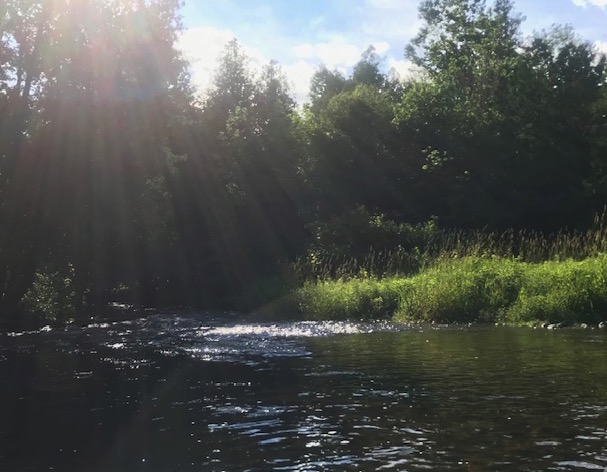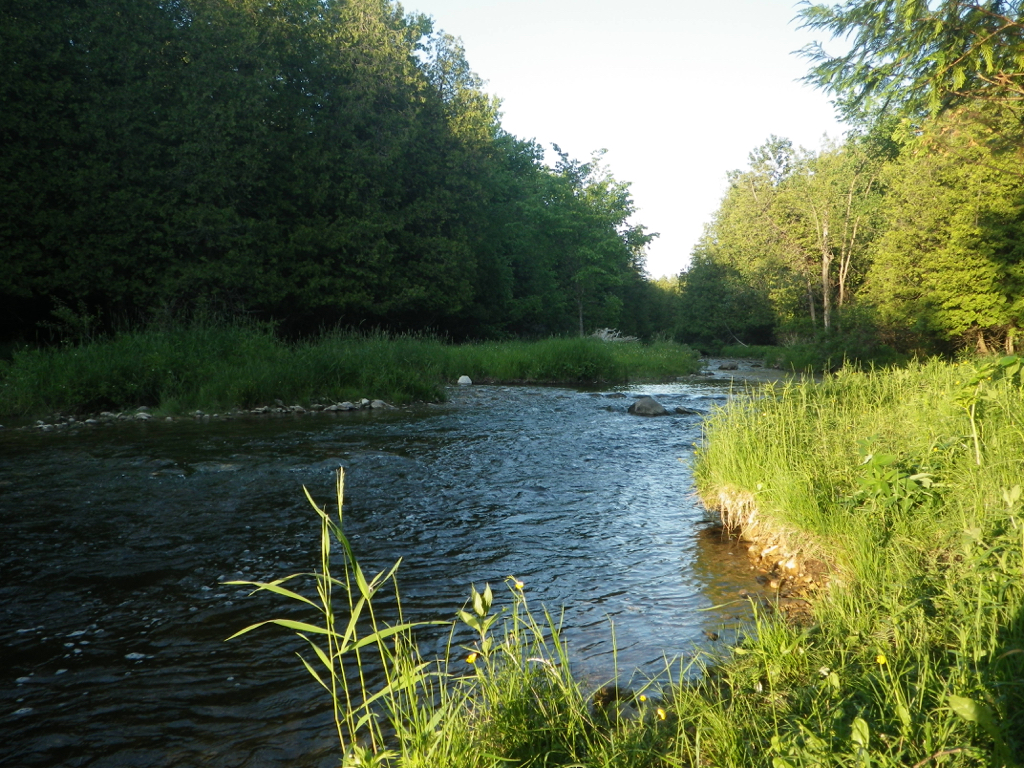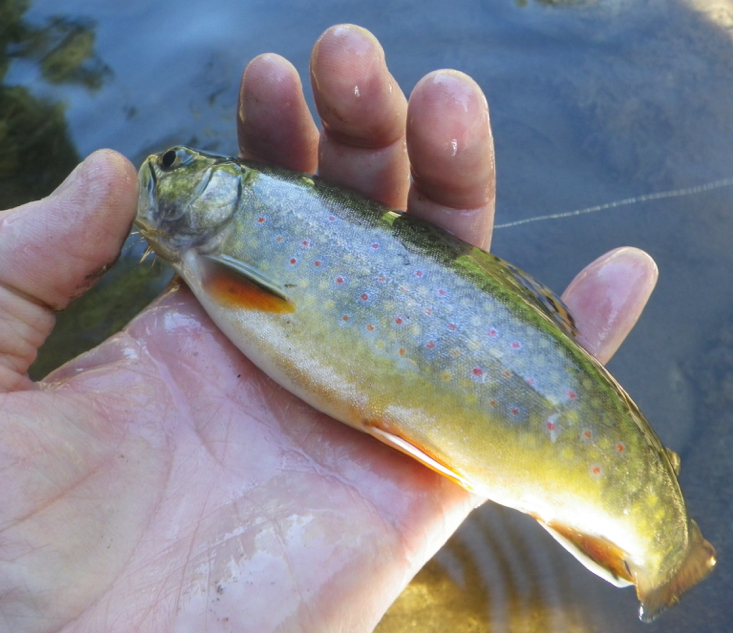It was early evening on the longest day of the year, celebrated by the ancients as the Feast of Midsummer.
I was on my way to do the kind of fly fishing I most cherish: rivertop trouting. The term was coined by Ted Williams—not the Boston Red Sox legend and dedicated fly fisherman but the esteemed outdoor, angling and conservation writer—who assigned such fishing to ‘secret, timeless’ places.
And that was exactly where I was headed.
I turned off the asphalt two-lane on to ‘a wagon-rutted road’ (in the words of Jesse Winchester) and was greeted by a furry, four-legged, tail-waging guardian as I cautiously drove pass the landowner’s house. I parked my Jeep in a small meadow bejeweled with a profusion of rhinestone butterflies and moths.
I geared up—waders, wading boots, fly box-stuffed vest, Polaroid shades and oilskin hat bedecked with partridge, bluejay and downy woodpecker feathers (all retrieved from the forest floor). I assembled my Sweetgrass five-weight bamboo rod and placed my copper-plated Orvis CFO in the reel seat. I unfurled line and drew it along with a 6X tapered leader through the snake guides to the rod tip. I decided to delay tying on a fly until I got to the river and checked out the insect activity.
This ritual served as preparation for the communion between angler and river I was about to receive.
The sense of anticipation rose within my body, remnants of a joy I remembered from childhood. I sauntered along a cedarwoods path, acknowledging a tree with roots suggesting the bent knees and voluptuous thighs of a Henry Moore sculpture. Suddenly, as if by magic, the freestone headwater opened up before my eyes–literally. I stopped and breathed deeply, immersed in the sensual immediacy of my surroundings. I placed my rucksack, containing a flask of single malt and tin of salted nuts, in riverside grasses. These treats were for later.
For me, this stretch of Southwestern Ontario headwater is a holy place: source, alpha, first cause and garden before the fall.

I was reminded of Odell Shepard, a Pulitzer-winning scholar of New England transcendentalism whose appreciation of fly fishing set the standard to which I aspire. Fly angling literature in the modern era would be poorer were it not for the literary scholars who put perspicacious pens to paper.
In his lovely memoir Thy Rod and Thy Creel, Shepard writes of watching another fly fisherman on one of England’s hallowed rivers:
. . . while I stood and watched this expert angler it was suddenly borne in upon me that here was a mystery of which I knew almost nothing whatsoever, that here was a sport carried to the verge of art and well beyond the boundaries of scholarship. I saw that trout-fishing might amount to a good deal more than merely ‘catching a mess of fish.’ It had a code, a technique, a tradition, a history.
Although academia displaced the church somewhat in twentieth century fly angling literature, spirituality was not forsaken—far from it. Ecumenical and intellectual elements coalesced in the best writing devoted to the contemplative recreation. In A River Runs Through It, one of the great works in fly angling’s rich literary history, Norman Maclean—who shared his love of Shakespeare and the Romantic poets with the Blackfoot River—casts a graceful line across the parallel currents of clergy and clerisy.
With Shepard’s words whispering in my ear, I gazed on what my angling companions, Dan Kennaley and Wesley Bates, and I call ‘the big pool.’ This is where the big trout in this part of the river reside. I fought the temptation to cast a line. I would not fish it now; instead, I would save it until returning at eventide. Delaying the gratification that accompanies the potential of landing a big fish is a ritual my companions and I follow religiously.
I have been fishing this headwater, which is no more than ten metres wide, since I began fly fishing more than fifteen years ago. Dan introduced it to me. He and a couple of longtime angling pals have been coming here for four decades. Because it wanders through private property few anglers gain access. It is as close to an earthly paradise as I’m able to imagine.
I stepped into the water and moseyed downriver to where I intended to initiate my solitary piscatorial adventure. I took my time, enjoying the wade. The water was a bit stained but visibility was good; its temperature was cool and refreshing, making for contented trout which, if all goes well, would make for a contented angler.
A gentle breeze came from the direction in which I was headed. I was not aware of any breeze at the meadow but welcomed it here. It would keep the mosquitoes at bay without being strong enough to complicate casting. I began looking for friendlier aquatic insects: mayflies and caddisflies, the occasional stonefly—the food of trout.
I came to a small island and made a series of short casts to small pools that usually hold trout. I had a couple of hits but my zeal got the best of me. Even failing to set the hook proved satisfying because there were fish where I had expected. Reading the water is an imperfect science, equal parts observation, experience and intuition. It also involves something anglers seldom acknowledge: the hospitality of fish who welcome into their home strangers waving long wimpy sticks.
When I fish the headwater with Dan, he bushwhacks downriver and wades his way back to where we gather at the big pool. Wesley and I fish closer together, exchanging ideas on methods and techniques. In the absence of both companions, I decided to explore a flourishing current seam and pool downriver from where I customarily fish.
Rocks haphazardly traverse the river, creating a natural ledge that causes water to burble and gurgle in a long luxurious seam. It is shielded from the sun for much of the day by cedars and overhanging willows that suit resident trout. Adjacent to the broiling seam is a pool where pods of accommodating trout hang out.
This stretch of headwater is a bug factory that attracts silky cedar waxwings. Sporting rakish black masks, these handsome birds (one of my favourite species) gather in the cedars when not performing dazzling aeronautics above the river in pursuit of flying insects, their thin, high-pitched whistles piercing the air.

My game plan was to start at the tail of the pool, slowly and systematically working my way up to its head immediately below the ledge. I would repeat the strategy with the fecund current seam.
I took a moment to consider the fly I would tie onto my tippet. Isonychia mayflies were flying about and floating on the water after depositing eggs. Although sparse they were thick enough to make the decision for me.
Known variously as Lead-wing Coachman, Dun Variant, Slate Drake, Slate Dun or, most whimsically, White-gloved Howdy, Isonychia are a model of dependability on rivers across southwestern Ontario from June through September because of what I call a ‘double-header’ hatch (an early one starting mid-June and a late one starting at the end of August, depending on location). Not surprisingly fly anglers are enamoured of this meaty mayfly. And I’m no exception.
I selected a fly to match the hatch—one of Dan’s expertly tied comparaduns, a lethal dry fly inspired by Fran Better’s legendary haystack pattern. I stripped out line and made a few tentative casts. Like a relief pitcher in the bullpen, I was warming up in preparation of the precision yet to come (or so I hoped).
Soon I fell into a rhythm (physical) that carried me to my happy place (mental). My conversation with the river continued on amiable terms. Not all of my casts were perfect which, for me, is to be expected. Still a good cast is a beautiful thing. It accounts for much of fly fishing’s elegance and grace, not to mention mystique. It is as close as fishing gets to ballet on water.
I was immersed in the sounds of the headwater—a natural symphony of insects and birds, wind caressing leaves and polyphonous current. The river slowly seeped into my bones. I relaxed, feeling at peace with myself and the world around me, of which I became an integral part.
I was blessed on this evening in the month of my seventieth year on the lip of the summer solstice.
Suddenly the line twitched and tightened. I flicked the tip of my Sweetgrass and it began humming a sweetly pleasing note. The dance on water began. Time stopped and space contracted. It was me and the trout embraced in ‘the still point of the turning world,’ in T. S. Eliot’s words.
Playing a fish is a choreographed pas de deux. I wanted to prolong the dance but I also wanted to land her (for purposes of this essay she will be a hen) before she became fatigued. Catch and release is more than an ethic, it is an act of devotion on the altar of preservation. I knelt down into the water.
‘My God, she’s a brookie,’ I whispered. ‘What a beauty.’ I wet my hands, cupped her in my palm and turned her upside down to relax her before carefully removing the barbless hook from her pouting lip. I returned her to the water until she revived and, within a flash, was gone.

A brook trout—or speckled trout or speck—is a miracle. Holding one, if only momentarily, connected me to raw, fierce, wild nature. It was both a gift and a privilege.
I was lucky on this night—Shepard observes that fly fishing depends on ‘a very large element of chance and uncertainty’—as shadows lengthened on the water and darkness fell softly as a mourning veil.
I left the river after catching and releasing a dozen trout. As it turned out, the big pool did not deliver on its promise. No matter. The tally: nine rainbows and two browns, all ranging from six to eleven inches, in addition to the lone, ten-inch brookie. When it comes to rivertop trouting size is of little consequence.
I sat bankside overlooking the big pool, taking deep delight in occasional riseforms (taunting reminders that trout always enjoy the last laugh). A constellation of twinkling fireflies pierced pinpricks of yellow luminescence in a curtain of deep dark indigo.
My Celtic ancestors venerated riverbanks–where earth meets water–as liminal, luminous places. In honour I poured a dram of 15-year-old Dalwhinnie, a distillers vintage from 1990, double-matured in oloroso sherry wood and bottled in 2005. Derived from the Gaelic word Dail Chuinnidh (meaning ‘meeting place’), it serves as a bridge between Highland and Speyside whiskies, offering a light fruit and honey character with classic heather and a wee trace of peat.
It was the perfect malt whisky to savour at this perfect place. Although a solitary outing, I was never alone on the headwater.
I toasted angling companions, all of whom I have shared bankside drams: Gary Bowen, the university pal who reintroduced me to fishing after a thirty-five year hiatus; Dan, a fly angling mentor who became a dear friend; Wes, a creative collaborator who helped me become a published author after four decades as a professional journalist; Chris Pibus, a longtime fly angler I met through my book before discovering we shared a love of literature, art and trout streams (who gifted me the Dalwhinnie); and Dylan, my eldest son who took up fly rod and reel after discovering, as his dad had before him, that an Adam’s dry fly is a prescription to mend a broken heart.
I felt a deep sense of thanksgiving as I made my way through the cedar forest back to the Jeep. While taking off my gear I was serenaded by the urgent throb of a drumming ruffed grouse engaged in his annual mating ritual, a warning to other males and an invitation to females.
Thinking of Shepard once again, I took solace from his observation that no activity ‘carries one so far toward the secret heart of nature as angling.’